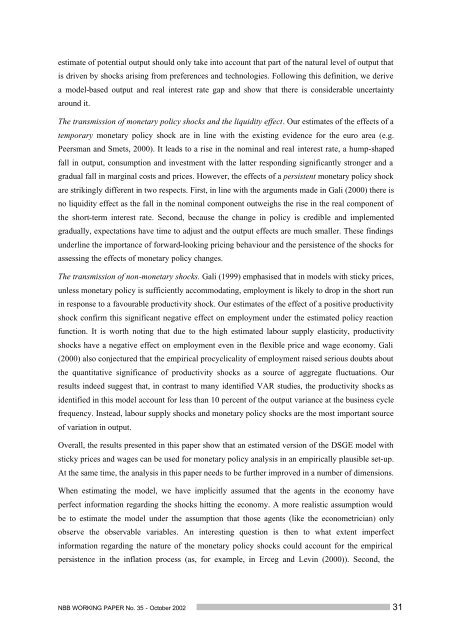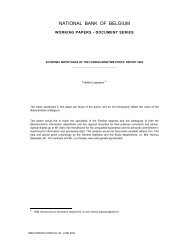An estimated dynamic stochastic general equilibrium model of the ...
An estimated dynamic stochastic general equilibrium model of the ...
An estimated dynamic stochastic general equilibrium model of the ...
Create successful ePaper yourself
Turn your PDF publications into a flip-book with our unique Google optimized e-Paper software.
estimate <strong>of</strong> potential output should only take into account that part <strong>of</strong> <strong>the</strong> natural level <strong>of</strong> output thatis driven by shocks arising from preferences and technologies. Following this definition, we derivea <strong>model</strong>-based output and real interest rate gap and show that <strong>the</strong>re is considerable uncertaintyaround it.The transmission <strong>of</strong> monetary policy shocks and <strong>the</strong> liquidity effect. Our estimates <strong>of</strong> <strong>the</strong> effects <strong>of</strong> atemporary monetary policy shock are in line with <strong>the</strong> existing evidence for <strong>the</strong> euro area (e.g.Peersman and Smets, 2000). It leads to a rise in <strong>the</strong> nominal and real interest rate, a hump-shapedfall in output, consumption and investment with <strong>the</strong> latter responding significantly stronger and agradual fall in marginal costs and prices. However, <strong>the</strong> effects <strong>of</strong> a persistent monetary policy shockare strikingly different in two respects. First, in line with <strong>the</strong> arguments made in Gali (2000) <strong>the</strong>re isno liquidity effect as <strong>the</strong> fall in <strong>the</strong> nominal component outweighs <strong>the</strong> rise in <strong>the</strong> real component <strong>of</strong><strong>the</strong> short-term interest rate. Second, because <strong>the</strong> change in policy is credible and implementedgradually, expectations have time to adjust and <strong>the</strong> output effects are much smaller. These findingsunderline <strong>the</strong> importance <strong>of</strong> forward-looking pricing behaviour and <strong>the</strong> persistence <strong>of</strong> <strong>the</strong> shocks forassessing <strong>the</strong> effects <strong>of</strong> monetary policy changes.The transmission <strong>of</strong> non-monetary shocks. Gali (1999) emphasised that in <strong>model</strong>s with sticky prices,unless monetary policy is sufficiently accommodating, employment is likely to drop in <strong>the</strong> short runin response to a favourable productivity shock. Our estimates <strong>of</strong> <strong>the</strong> effect <strong>of</strong> a positive productivityshock confirm this significant negative effect on employment under <strong>the</strong> <strong>estimated</strong> policy reactionfunction. It is worth noting that due to <strong>the</strong> high <strong>estimated</strong> labour supply elasticity, productivityshocks have a negative effect on employment even in <strong>the</strong> flexible price and wage economy. Gali(2000) also conjectured that <strong>the</strong> empirical procyclicality <strong>of</strong> employment raised serious doubts about<strong>the</strong> quantitative significance <strong>of</strong> productivity shocks as a source <strong>of</strong> aggregate fluctuations. Ourresults indeed suggest that, in contrast to many identified VAR studies, <strong>the</strong> productivity shocks asidentified in this <strong>model</strong> account for less than 10 percent <strong>of</strong> <strong>the</strong> output variance at <strong>the</strong> business cyclefrequency. Instead, labour supply shocks and monetary policy shocks are <strong>the</strong> most important source<strong>of</strong> variation in output.Overall, <strong>the</strong> results presented in this paper show that an <strong>estimated</strong> version <strong>of</strong> <strong>the</strong> DSGE <strong>model</strong> withsticky prices and wages can be used for monetary policy analysis in an empirically plausible set-up.At <strong>the</strong> same time, <strong>the</strong> analysis in this paper needs to be fur<strong>the</strong>r improved in a number <strong>of</strong> dimensions.When estimating <strong>the</strong> <strong>model</strong>, we have implicitly assumed that <strong>the</strong> agents in <strong>the</strong> economy haveperfect information regarding <strong>the</strong> shocks hitting <strong>the</strong> economy. A more realistic assumption wouldbe to estimate <strong>the</strong> <strong>model</strong> under <strong>the</strong> assumption that those agents (like <strong>the</strong> econometrician) onlyobserve <strong>the</strong> observable variables. <strong>An</strong> interesting question is <strong>the</strong>n to what extent imperfectinformation regarding <strong>the</strong> nature <strong>of</strong> <strong>the</strong> monetary policy shocks could account for <strong>the</strong> empiricalpersistence in <strong>the</strong> inflation process (as, for example, in Erceg and Levin (2000)). Second, <strong>the</strong>NBB WORKING PAPER No. 35 - October 2002 31
















